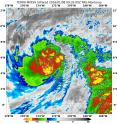NASA investigates Tropical Storm Pali's temperatures, winds
The Central Pacific Ocean's out-of-season tropical depression has strengthened into a tropical storm and has been renamed Pali. NASA's RapidScat instrument and Terra satellite gathered wind and temperature data on the unusual storm far to the southwest of Hawaii. On January 7, the RapidScat instrument that flies aboard the International Space Station measured the surface winds in the then tropical depression 1C. RapidScat measures wind speed at the surface which is always lower than speeds at higher altitude. Maximum sustained winds are not always equally distributed in a hurricane or tropical storm, and the RapidScat instrument helps forecasters find the strongest quadrants of a storm.
Tropical Depression 1C's strongest winds appeared in the southwestern quadrant of the storm at 30 meters per second (67.1 mph/ 108 kph). Winds around the rest of the depression were less intense. By Jan. 8, the depression strengthened into a tropical storm.
On Jan. 8 at 09:35 UTC (4:35 a.m. EST) the Moderate Resolution Imaging Spectroradiometer or MODIS instrument aboard NASA's Terra satellite measured temperatures of Pali's cloud tops. MODIS data was false-colored at the U.S. Naval Research Laboratory in Washington, D.C. and showed powerful thunderstorms with cloud top temperatures between minus 70 and minus 80 degrees Fahrenheit (minus 56.6 and minus 62.2 Celsius) circled the center.
On Jan. 8 at 0900 UTC (4 a.m. EST/ 11 p.m. HST Jan. 7) the center of Tropical Storm Pali was located near latitude 5.9 north and longitude 171.8 west. That's about 1,410 miles (2,275 km southwest of Honolulu, Hawaii and 760 miles (1,255 km) south-southwest of Johnston Island. Pali was moving toward the northwest near 8 mph (13 kph) and a turn toward the west-northwest is forecast by late Saturday.
Maximum sustained winds were near 50 mph (85 kph) and little change in intensity is expected for the next 36 hours with slow weakening expected thereafter. The estimated minimum central pressure is 997 millibars. The storm is not a threat to any land areas.
Forecaster Wroe of NOAA's Central Pacific Hurricane Center said that since Pali is located in the deep tropics "ocean temperatures are sufficiently warm for additional intensification." However with easterly vertical winds shear around 25 knots (28.7 mph/46.3 kph), some data indicating some westward tilt with height to the cyclone and continued interaction with the low level trough (elongated area of low pressure) the potential for intensification is limited over the next few days.
For updated forecasts on Pali, visit: http://www.prh.noaa.gov/cphc.
Source: NASA/Goddard Space Flight Center
Articles on the same topic
- Former Hurricane Pali peters out near EquatorFri, 15 Jan 2016, 19:42:01 UTC
- NASA sees Tropical Depression Pali headed toward EquatorThu, 14 Jan 2016, 20:15:08 UTC
- NASA analyzes Hurricane Pali's rainfall ratesWed, 13 Jan 2016, 18:45:43 UTC
- NASA's Terra satellite spots record-breaking Hurricane PaliTue, 12 Jan 2016, 16:55:47 UTC
- NASA eyeing an interesting weather system in northern AtlanticMon, 11 Jan 2016, 20:27:25 UTC
- Unusual Tropical Storm Pali still thriving far from HawaiiMon, 11 Jan 2016, 18:52:32 UTC
- NASA sees out-of-season Central Pacific tropical depression formFri, 8 Jan 2016, 22:23:54 UTC
Other sources
- Former Hurricane Pali peters out near Equatorfrom PhysorgFri, 15 Jan 2016, 21:24:29 UTC
- NASA sees Tropical Depression Pali headed toward Equatorfrom PhysorgThu, 14 Jan 2016, 20:45:39 UTC
- NASA analyzes Hurricane Pali's rainfall ratesfrom PhysorgWed, 13 Jan 2016, 18:32:13 UTC
- A Hurricane? In January? You Can Thank El Niñofrom Live ScienceWed, 13 Jan 2016, 3:04:04 UTC
- NASA's Terra satellite spots record-breaking Hurricane Palifrom Science DailyTue, 12 Jan 2016, 22:34:03 UTC
- NASA satellite photographs record-breaking Hurricane Palifrom UPITue, 12 Jan 2016, 20:12:31 UTC
- Terra satellite spots record-breaking Hurricane Palifrom PhysorgTue, 12 Jan 2016, 17:41:00 UTC
- NASA eyeing an interesting weather system in northern Atlanticfrom PhysorgMon, 11 Jan 2016, 20:54:26 UTC
- Unusual Tropical Storm Pali still thriving far from Hawaiifrom PhysorgMon, 11 Jan 2016, 19:20:56 UTC
- Unusual January tropical storm forms southwest of Hawaiifrom PhysorgFri, 8 Jan 2016, 23:23:08 UTC
- Unusual January tropical storm forms southwest of Hawaiifrom AP ScienceFri, 8 Jan 2016, 22:21:02 UTC
- NASA investigates Tropical Storm Pali's temperatures, windsfrom PhysorgFri, 8 Jan 2016, 19:44:47 UTC
- NASA sees out-of-season Central Pacific tropical depression formfrom PhysorgFri, 8 Jan 2016, 0:04:59 UTC

